|
On the western edge of the stone forest lies the border of the organized
monasticism of Meteora.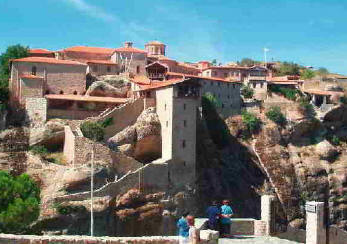
The Holy
Monastery of the Transfiguration of Jesus is also called the “Great
Meteoron”, not only due to its 50 acres length and the size of its
buildings but also due to the spiritual primacy and radiance it enjoyed
in the mid-16th century.
The monastery is perched on the high and
imposing rock with a height of 613m. above the sea level and 416m. away
from the bed of the river Pineios .
Saint
Athanasios the Meteorites, a scholarly monk, lead an ascetic lifestyle
on a rock named the “Stylo ton Stagon”. He was the first to climb the
Platys Lithos (“Broad Rock”), accompanied by fourteen monks.
They dag
holes in the
steep rock, they stack beams, constructed scaffolds and managed to reach
a point where the birds alone could access. 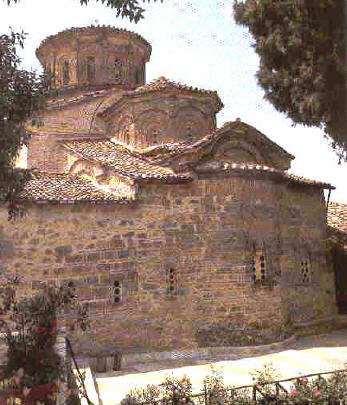
There, between the earth and the sky, at the edge of a vertical
cliff, Athanasios the Meteorites, built Theomitoros monastery around
1340 AD, organized the first systematic monastic community and erected
the church of Theomitoros.
Later, he constructed another church
consecrated
in honour of the transfiguration of the Savior Jesus Christ, which
constituted the Katholikon of the monastery and is called the Monastery
of the Transfiguration of Jesus Christ until the current day.
Athanasios was not alone in this endeavor.
His successor and
second proprietor of the Holy Monastery was the monk, Saint Ioasaf (John
Uros) that is the son of the Serbian-Greek king, Symeon Uros Paleologos
who supported the Monastery financially.
In earlier times, access to the monastery was achieved through
ladders and the Tower (in 1520), where the loft with the net dominated,
which is still employed by the elderly pilgrims to carry goods.
Until 1923, ascent
was accomplished by means of ladders and nets.
Nowadays, the ascent is succeeded by
means of a flight of 146 short and steep stairs leading to the entrance
of the monastery.
The first small building that can be found inside the rock, on the
left side of the stairs is the hermitage of the founder of the
monastery. Entering the main entrance, on the right, one comes to terms
with the old winch.
The view at the edge of the cliff is breathtaking. After climbing the
stairs, the sacristy, the old cooking area and the cellar are
discernible.
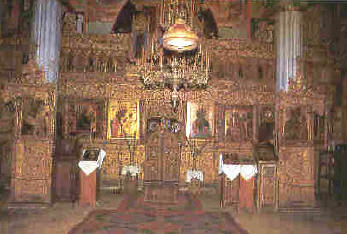
Getting to the top, one can witness the glorious structure of the
monastery, the imposing Katholikon, with a length of 32 m and a width of
24 m.
The church has a Greek-cross-in-square floor plan, with a 12-sided
central dome resting on a drum
following the architectural Athonic type and was built in 1544-45 AD.
The Katholikon is divided into exonarthex, narthex, nave and the
sanctuary. The nave frescoes were painted in 1552 under the assumed
authority of Abbot Simeon and constitutes one of the most brilliant
fresco sets of the meta - Byzantine painting era.
The Bema which formed the first Katholikon of the monastery was
constructed before 1380 AD, by the founder of the Monastery Saint
Athanasios who died in the year 1380 and was succeeded by Saint Ioasaf.
Our church
celebrates them both on the 20th of April.
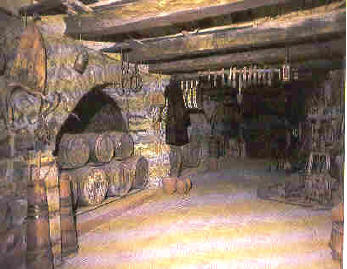
Saint Ioasaf completed and frescoed the
Katholikon of the monastery in 1484 AD. The nave is bright and filled
with frescoes. The iconostasis is carven and glided. It was constructed
in 1617 AD and includes images taken from the vegetable and animal
kingdom.
The icons of the iconostasis belong to different eras and are
important for their artistry and their age. A great sample of wood
carving can be seen on the Episcopal throne which was constructed in
1617 AD. It is wooden and the images are derived from the vegetable
kingdom. Both lecterns are made of wood with various marble and ivory
designs. The old wooden icon stand in the nave has several flowery
depictions and was completed under the authority of the Abbot Parthenios
Orfidis.
There are 3 chapels at the Grand Meteoron:
1. The chapel of John the Baptist.
2. The chapel of Sts Constantine and Helena. It was built in 1789 and
its characteristics place it among the polygonal domed basilicas.
3. The chapel of St.
Athanasios.
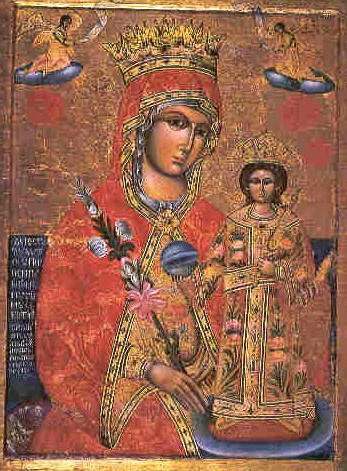
The 32 metres’
dining table, an eating area of all monks, has been converted into a
museum with interesting exhibits.
Priceless treasures are preserved in the
library of the monastery:
-
manuscripts, Byzantine and post-Byzantine
documents.
• manuscripts, a spiritual output of the 9th -
19th century.
• books
concerning the function of the monastery, patristic texts,
hymnographical texts, rare incunabula of 15th-19th century, the total
number of which are 450 volumes.
• collection of music and legal manuscripts and
ancient texts (Homer, Sophocles, Demosthenes, Hesiod, Aristotle, the
Alexandrian writers).
It is one of
the wealthiest monastic libraries. It also served as a bibliographic
workshop in the 16th - 17th century.
A wide
collection of gold-embroidered cloths is also kept in the museum:
• the Altar
table, a gold-embroidered apron, crosses, golden epitrachilia,
embroidered Epitaphs.
One should
also pay special attention to the beautifully decorated, silver
reliquaries where the relics of our holy fathers are reverently stored.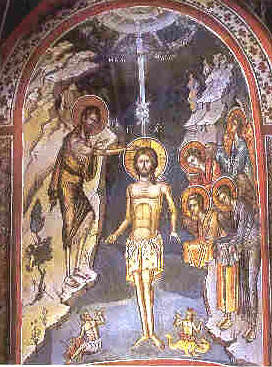
Before leaving, the visitor should not miss a short tour to the
monastery’s courtyard, where one may admire a wonderful view over the
river Pineios and the Mount Koziakas.
The monks follow
strict regulations and gather at the church 4 times a day, Orthodox
liturgy lasts about 6 hours a day.
The practice of
the monastic life, which is the monks’ main concern, is in absolute
agreement with the imperative morals of the Holy Fathers of the Orthodox
Church.
There is both social activity and spiritual support of the
pilgrimages, which stems from our saints’ miraculous grace.
The monastery has offered a great deal to our
nation, education and our culture. It constitutes a vibrant monastic
community for more than
six hundred and fourteen years, a bastion of true Christianity and the
traditions of Hellenism.
Monks devoted to Christ, carrying prayers in their hearts and
building materials on their backs, renovate, restore and preserve the
monastery, celebrating its ritualistic beauty. As a result, every year,
pilgrims and tourists are getting overwhelmed by the great mission
undertaken there.
Translation by Christine Boutsia
|
OPENING HOURS OF THE HOLY MONASTERY OF THE GREAT METEORON |
|
SUMMER
9.00 am to 5.00
p.m.
Closed on Tuesdays |
|
WINTER
9.00
am
to
4.00
p.m.
Closed
on Tuesdays and Wednesdays. |
|
Telephone Number:
24320-22.278 |
|